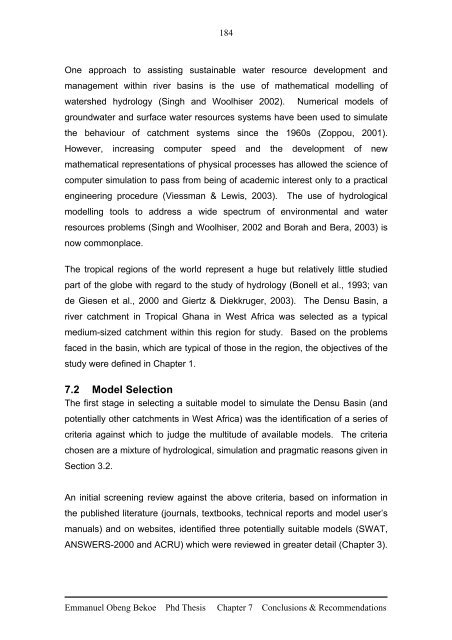PhD Thesis Emmanuel Obeng Bekoe - Cranfield University
PhD Thesis Emmanuel Obeng Bekoe - Cranfield University
PhD Thesis Emmanuel Obeng Bekoe - Cranfield University
Create successful ePaper yourself
Turn your PDF publications into a flip-book with our unique Google optimized e-Paper software.
184<br />
One approach to assisting sustainable water resource development and<br />
management within river basins is the use of mathematical modelling of<br />
watershed hydrology (Singh and Woolhiser 2002). Numerical models of<br />
groundwater and surface water resources systems have been used to simulate<br />
the behaviour of catchment systems since the 1960s (Zoppou, 2001).<br />
However, increasing computer speed and the development of new<br />
mathematical representations of physical processes has allowed the science of<br />
computer simulation to pass from being of academic interest only to a practical<br />
engineering procedure (Viessman & Lewis, 2003). The use of hydrological<br />
modelling tools to address a wide spectrum of environmental and water<br />
resources problems (Singh and Woolhiser, 2002 and Borah and Bera, 2003) is<br />
now commonplace.<br />
The tropical regions of the world represent a huge but relatively little studied<br />
part of the globe with regard to the study of hydrology (Bonell et al., 1993; van<br />
de Giesen et al., 2000 and Giertz & Diekkruger, 2003). The Densu Basin, a<br />
river catchment in Tropical Ghana in West Africa was selected as a typical<br />
medium-sized catchment within this region for study. Based on the problems<br />
faced in the basin, which are typical of those in the region, the objectives of the<br />
study were defined in Chapter 1.<br />
7.2 Model Selection<br />
The first stage in selecting a suitable model to simulate the Densu Basin (and<br />
potentially other catchments in West Africa) was the identification of a series of<br />
criteria against which to judge the multitude of available models. The criteria<br />
chosen are a mixture of hydrological, simulation and pragmatic reasons given in<br />
Section 3.2.<br />
An initial screening review against the above criteria, based on information in<br />
the published literature (journals, textbooks, technical reports and model user’s<br />
manuals) and on websites, identified three potentially suitable models (SWAT,<br />
ANSWERS-2000 and ACRU) which were reviewed in greater detail (Chapter 3).<br />
<strong>Emmanuel</strong> <strong>Obeng</strong> <strong>Bekoe</strong> Phd <strong>Thesis</strong> Chapter 7 Conclusions & Recommendations

















